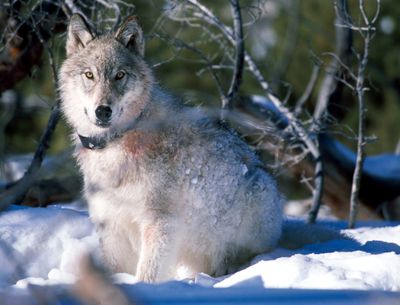Wolf decision not the final word

Westerners might want to hold off for a bit before reacting too strongly to the government’s announcement that wolves in most northern states should be removed from the Endangered Species List.
It remains to be seen whether Wednesday’s decision will hold, leading to hunting seasons for wolves in Idaho and Montana.
After all, three presidents already have been directly involved in modern efforts to restore wolves in the West. And a fourth soon will get his chance.
“We are hopeful that the Obama administration will block this rule from going into effect,” Bob Irvin, senior vice president of Defenders of Wildlife, said Wednesday. “There are several options for doing so.”
Gray wolves were among the first species given federal protection after President Nixon signed the Endangered Species Act in 1973. Bill Clinton was president when serious recovery efforts began with the reintroduction of 66 wolves in Idaho and Yellowstone National Park over a two-year period.
Eleven months ago, the U.S. Fish and Wildlife Service announced that the federal government would stop managing wolves in the Midwest and Northern Rockies. Wyoming nearly immediately began to allow unregulated hunting in most of the state, while Montana and Idaho began plans for tightly controlled hunting seasons. An environmental lawsuit ensued, and a federal judge restored protections in July.
On Wednesday, six days before President Bush leaves office, agency officials announced that they think they’ve answered the judge’s concerns and are again lifting federal protections for wolves.
The decision applies in Montana and Idaho, portions of Washington, Oregon and Utah, and the upper Midwest. Wyoming is excluded, until the state comes up with a management plan that federal biologists say won’t threaten the species.
With the northern Rockies wolf population at an estimated 1,517, the time for federal protection has passed, Deputy Interior Secretary Lynn Scarlett said during a news conference. For the first time since the 1930s, wolf packs were confirmed last year in Eastern Washington and northeastern Oregon, where they remain protected by state laws.
“We believe this is a major success story for conservation,” Scarlett said.
But Wednesday’s decision hasn’t yet been published in the Federal Register, a step that will start a 30-day review period. Scarlett and other federal officials acknowledged Wednesday that it could be reversed by the Obama administration.
Whether that happens depends partly on Obama’s pick for Interior secretary, U.S. Sen. Ken Salazar, whose ancestors helped found Santa Fe in 1598, when no one could have imagined a West without ? wolves. (The government does not propose ending federal protection for the estimated 52 gray wolves surviving in the Southwest.)
Obama’s selection of Salazar was opposed by some environmental groups and biologists, who noted that as Colorado’s attorney general, he fought federal protection for some species. A spokesman for WildEarth Guardians of Santa Fe told the Associated Press in December that Salazar is at best “not interested” in endangered species issues.
But if Salazar has an opinion on wolf recovery, he hasn’t made it known, said Irvin, of Defenders of Wildlife, which did not oppose Salazar’s selection.
Opinions about wolves remain strong in the West, where many hunters and ranchers contend they’re devastating elk herds and killing too many domestic animals. Despite federal protection, nearly 250 Western wolves were “lethally removed” by ranchers and wildlife agents in 2008 because they were involved in killing livestock.
Illegal killings have been common since wolves started expanding their range in the late 1990s. “Smoke a pack a day,” reads a popular T-shirt, featuring a picture of a wolf in crosshairs.
The Idaho Legislature never revoked a 2001 resolution calling for the “immediate removal” of all wolves from the state. Last year, the Central Idaho Anti-Wolf Coalition gathered 35,000 signatures on petitions calling for wolf extermination – 10,000 shy of the signatures needed for a statewide vote.
But federal authorities have made clear that wolves will return to the Endangered Species list if states don’t maintain viable populations. For that reason, Idaho in 2002 reluctantly agreed to a management plan that promises to maintain at least 10 breeding pairs, a quarter of the number now in the state. Last year, during the brief period in which the states were given control of wolves, the state began planning to let hunters kill 100 to 300 of the animals, with Gov. Butch Otter saying he hoped to be the first in line for a hunting license. “Our plan is to manage wolves as we do other big game,” Idaho Department of Fish and Game Director Cal Groen said Wednesday in a news release.